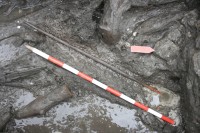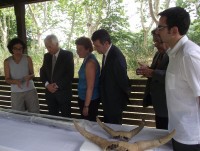 A research team from the Universitat Autònoma de Barcelona (UAB) and the National Scientific Research Council (CSIC) in Catalonia has unearthed a complete Neolithic yew bow at the La Draga archaeological site on the Lake of Banyoles in northeastern Catalonia, Spain. The bow is 42.5 inches long (108 centimeters) and dates to between 5400 and 5200 B.C., the earliest period of settlement in the area, which makes it the oldest Neolithic bow ever found in Europe.
A research team from the Universitat Autònoma de Barcelona (UAB) and the National Scientific Research Council (CSIC) in Catalonia has unearthed a complete Neolithic yew bow at the La Draga archaeological site on the Lake of Banyoles in northeastern Catalonia, Spain. The bow is 42.5 inches long (108 centimeters) and dates to between 5400 and 5200 B.C., the earliest period of settlement in the area, which makes it the oldest Neolithic bow ever found in Europe.
These aren’t the oldest bows in Europe, just to be clear. That title goes to Paleolithic bows discovered in the Holmegård Swamp in Denmark in the 1940s. Two elm bows found there date to around 6,000 B.C. One of them is complete, has a biconvex (curved on both sides) D-shaped center section with flat arms, and at five feet long is considerably larger than the La Draga bow. Arrows have been found in Germany from 9,000-8,000 B.C.
 This recently discovered bow is the oldest yet found from the dawn of agriculture in Neolithic Europe. Earlier excavations in 2002 and 2005 discovered fragments of bows from the same period, but they were too small for scientists to derive any new information about the tools, including their manufacture and use. Other Neolithic bows have been found in central and northern Europe, but they are newer than the La Draga discoveries and also fragmentary. This long plano-convex (curved on one side, straight on the other) ancient bow will allow scientists detailed analysis and reveal new information not just about how the bow was made and used, but also about the technology, rituals, and culture of one of the first farming communities in Europe.
This recently discovered bow is the oldest yet found from the dawn of agriculture in Neolithic Europe. Earlier excavations in 2002 and 2005 discovered fragments of bows from the same period, but they were too small for scientists to derive any new information about the tools, including their manufacture and use. Other Neolithic bows have been found in central and northern Europe, but they are newer than the La Draga discoveries and also fragmentary. This long plano-convex (curved on one side, straight on the other) ancient bow will allow scientists detailed analysis and reveal new information not just about how the bow was made and used, but also about the technology, rituals, and culture of one of the first farming communities in Europe.
The site at La Draga is exceptional for several reasons. Firstly, due to its antiquity, which is considered to be one of the oldest of the Neolithic period existing in the Iberian Peninsula. Secondly, because it is an open-air site with a fairly continuous occupation. Lastly, and surely most remarkably, because of its exceptional conditions in which it is conserved. The archaeological levels are located in the phreatic layer surrounding Lake Banyoles, giving way to anaerobic conditions which favour the conservation of organic material. These circumstances make La Draga a unique site in all of the Iberian Peninsula, since it is the only one known to have these characteristics. In Europe, together with Dispilo in Greece and La Marmota in Italy, it is one of the few lake settlements from the 6th millennium BCE.
 It’s an incredibly varied early Neolithic site, particularly compared to its cave-bound contemporaries. Postholes from housing have been discovered, wood, stone and bone tools, decorative pieces, cereal grains, and more than 22,000 animal remains, most of them from domesticated animals like sheep, goats, pigs and cows. The ages of the animals indicate that they were used not just for meat, but for dairy production as well. The inhabitants also collected vegetables, fruits, berries and nuts, hunted wild oxen, boars, rabbits, deer, and fished from the lake and the ocean 30 miles away. In terms of diet alone, the folks at La Draga had a far better standard of living than people have in most of so-called civilized European history.
It’s an incredibly varied early Neolithic site, particularly compared to its cave-bound contemporaries. Postholes from housing have been discovered, wood, stone and bone tools, decorative pieces, cereal grains, and more than 22,000 animal remains, most of them from domesticated animals like sheep, goats, pigs and cows. The ages of the animals indicate that they were used not just for meat, but for dairy production as well. The inhabitants also collected vegetables, fruits, berries and nuts, hunted wild oxen, boars, rabbits, deer, and fished from the lake and the ocean 30 miles away. In terms of diet alone, the folks at La Draga had a far better standard of living than people have in most of so-called civilized European history.
That’s not to say that it’s definite that the bow was used to procure food. It could have had an entirely different purpose, been a symbol of social prestige, for instance, or a weapon of war or means of self-defense. That’s why the complete bow is such an exciting find; it might answer some of those questions while fragments cannot.
I think it was to procure food.
BENJAMIN RAUCHER
I was pleased to come across the original article recently and find it more detailed than many often are, complete with fun archaeojargon like ‘planar-convex’ and ‘phreatic layer’. 🙂
Basically I need a great article about civilized European history. Oh! this article is so nice. thanks….
Thanks for a beautiful article about my village! Archeologically and geologically a place not to miss!